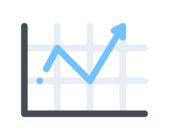
Averager Library
This library allows you to store data that changes over time in a space-efficient way, and retrieve it later. It's perfect for creating simple graphs of values like temperature.
There are two main classes:
Series
Instantiate this with a size (the number of buckets). You then call Series.add(value, bucket)
and the value supplied is kept as an average in that bucket.
The Averager assumes that you move linearly through bucket numbers when adding values. When you move from a high bucket number to a lower bucket number (eg if moving from the 31st of a month to the 1st of the next month) it saves the current set of buckets, and also adds them to the average.
Averager maintains three lists. Assuming the 'day of month example':
buckets- the current set of values (eg. data from this month)last- the last set of values (eg. complete data from last month)avr- an average of all values (eg. average for every day of every month)
Averager
This stores several Series instances for common time-based recording:
hours- A bucket every 15 minutes each daydays- A bucket for each day of the monthmonths- A bucket for each month of the year
Options
When you instantiate Series or Averager you have an object of options for how
data is stored. This contains:
format: optional type of array (defaultInt16Array)scale: optional scale to store data in the correct range for the array (default 1)offset: optional offset to store data correct range for the array (default 0)
For example:
- if you're storing temperature you might want to store it high res, so you could use the default
Int16Arraywhich stores values from -32768 to 32767, and then scale the temperature by 500, giving you roughly-65to+65range at 0.002 degree accuracy:{scale:500} - or you might want to save space and store low resolution, so you could use
Int8Arraywhich stores values from -128 to 127, and then scale the temperature by 2, giving you roughly the same-64to+64range but at 0.5 degree accuracy, using half the RAM:{format:Int8Array, scale:2}
Usage
var Averager = require("Averager").Averager;
var temperature = new Averager({scale:100});
setInterval(function() {
// every 10 seconds add new temperature data
temperature.add(E.getTemperature());
}, 10000);
You can use this with the graph library, so to plot the data so far today you could do:
require("graph").drawLine(g, temperature.series.hours.getCurrent(), {
axes : true,
gridy : 5,
gridx : 24,
xlabel : x=>(x>>2)+":00"
});
Or for a bar graph of the average each month, you could do:
require("graph").drawBar(g, temperature.series.months.getAvr(), {
axes : true,
gridy : 5,
gridx : 2,
xlabel : x=>"Jan,Mar,May,Jul,Oct,Nov".split(",")[x/2]
});
You can also call temperature.print() when accessing Espruino remotely
in order to get a JSON-formatted version of the data, for instance:
{
"hours": {
"current": [ 0.452, 0.192, 0.488, 0.576, 0.044, ... 0, 0, 0, 0, 0 ],
"avr": [ 0.196, 0.22, 0.188, 0.176, 0.216, ... 0.188, 0.196, 0.16, 0.188, 0.404 ],
"last": [ 0.092, 0.64, 0.388, 0.316, 0.604, ... 0.36, 0.4, 0.864, 0.676, 0.46 ]
},
"days": {
"current": [ 0.536, 0.516, 0.444, 0.5, 0.488, ... 0, 0, 0, 0, 0 ],
"avr": [ 0.44, 0.448, 0.448, 0.432, 0.46, ... 0.5, 0.484, 0.484, 0.496, 0.536 ],
"last": [ 0.544, 0.448, 0.532, 0.544, 0.588, ... 0.472, 0.512, 0.488, 0.508, 0.464 ]
},
months: {
"current": [ 0.508, 0.5, 0.504, 0.488, 0.5, 0.508, 0.508, 0.5, 0.484, 0, 0, 0 ],
"avr": [ 0, 0, 0, 0, 0, 0, 0, 0, 0, 0, 0, 0.492 ],
"last": [ 0, 0, 0, 0, 0, 0, 0, 0, 0, 0, 0, 0.492 ]
}
}
This page is auto-generated from GitHub. If you see any mistakes or have suggestions, please let us know.